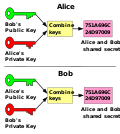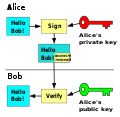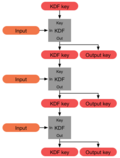Public-key cryptography, or asymmetric cryptography, is the field of cryptographic systems that use pairs of related keys. Each key pair consists of a...
40 KB (4,513 words) - 19:23, 4 June 2025
A key in cryptography is a piece of information, usually a string of numbers or letters that are stored in a file, which, when processed through a cryptographic...
13 KB (1,517 words) - 22:31, 1 June 2025
Symmetric-key algorithms are algorithms for cryptography that use the same cryptographic keys for both the encryption of plaintext and the decryption...
15 KB (1,540 words) - 19:12, 22 April 2025
Cryptography, or cryptology (from Ancient Greek: κρυπτός, romanized: kryptós "hidden, secret"; and γράφειν graphein, "to write", or -λογία -logia, "study"...
99 KB (11,007 words) - 11:28, 7 June 2025
In cryptography, key size or key length refers to the number of bits in a key used by a cryptographic algorithm (such as a cipher). Key length defines...
29 KB (3,225 words) - 01:39, 6 June 2025
In cryptography, a key signature is the result of a third-party applying a cryptographic signature to a representation of a cryptographic key. This is...
822 bytes (121 words) - 05:00, 26 July 2024
In computer security, a key server is a computer that receives and then serves existing cryptographic keys to users or other programs. The users' programs...
12 KB (1,617 words) - 05:18, 12 March 2025
This glossary lists types of keys as the term is used in cryptography, as opposed to door locks. Terms that are primarily used by the U.S. National Security...
9 KB (1,187 words) - 00:41, 29 April 2025
Post-quantum cryptography (PQC), sometimes referred to as quantum-proof, quantum-safe, or quantum-resistant, is the development of cryptographic algorithms...
63 KB (6,408 words) - 18:40, 5 June 2025
Secure key issuing is a variant of Identity-based cryptography that reduces the level of trust that needs to be placed in a trusted third party by spreading...
2 KB (291 words) - 16:09, 29 November 2024
Quantum key distribution (QKD) is a secure communication method that implements a cryptographic protocol involving components of quantum mechanics. It...
104 KB (11,926 words) - 13:55, 5 June 2025
Strong cryptography or cryptographically strong are general terms used to designate the cryptographic algorithms that, when used correctly, provide a very...
22 KB (2,846 words) - 19:45, 6 February 2025
International Association for Cryptologic Research (redirect from Public-key cryptography (conference))
cryptography, and one symposium: Crypto (flagship) Eurocrypt (flagship) Asiacrypt (flagship) Fast Software Encryption (FSE) Public Key Cryptography (PKC)...
31 KB (1,411 words) - 12:04, 28 March 2025
key exchange is a mathematical method of securely generating a symmetric cryptographic key over a public channel and was one of the first public-key protocols...
48 KB (5,437 words) - 22:41, 31 May 2025
Cryptography, the use of codes and ciphers, began thousands of years ago. Until recent decades, it has been the story of what might be called classical...
53 KB (6,893 words) - 16:19, 30 May 2025
example of quantum cryptography is quantum key distribution, which offers an information-theoretically secure solution to the key exchange problem. The...
82 KB (9,126 words) - 16:08, 3 June 2025
Elliptic-curve cryptography (ECC) is an approach to public-key cryptography based on the algebraic structure of elliptic curves over finite fields. ECC...
39 KB (4,677 words) - 13:04, 20 May 2025
it suitable for use in cryptography. It is also referred to as a cryptographic random number generator (CRNG). Most cryptographic applications require random...
29 KB (3,633 words) - 08:24, 16 April 2025
Key exchange (also key establishment) is a method in cryptography by which cryptographic keys are exchanged between two parties, allowing use of a cryptographic...
12 KB (1,397 words) - 19:44, 24 March 2025
constructions support important standards of post-quantum cryptography. Unlike more widely used and known public-key schemes such as the RSA, Diffie-Hellman or elliptic-curve...
24 KB (2,853 words) - 16:44, 3 June 2025
Digital signature (redirect from Signature (cryptography))
other cryptographic protocol. A digital signature scheme typically consists of three algorithms: A key generation algorithm that selects a private key uniformly...
45 KB (5,315 words) - 16:52, 11 April 2025
PKCS (redirect from Public-Key Cryptography Standards)
Public Key Cryptography Standards (PKCS) are a group of public-key cryptography standards devised and published by RSA Security LLC, starting in the early...
10 KB (343 words) - 13:37, 3 March 2025
RSA cryptosystem (redirect from RSA public key cryptography)
shared keys for symmetric-key cryptography, which are then used for bulk encryption–decryption. The idea of an asymmetric public-private key cryptosystem...
60 KB (7,783 words) - 17:51, 26 May 2025
Message authentication code (redirect from MAC (cryptography))
In cryptography, a message authentication code (MAC), sometimes known as an authentication tag, is a short piece of information used for authenticating...
16 KB (1,918 words) - 17:55, 22 January 2025
Certificateless cryptography is a variant of ID-based cryptography intended to prevent the key escrow problem. Ordinarily, keys are generated by a certificate...
4 KB (606 words) - 17:20, 16 February 2025
system; a key setup phase, where a symmetric encryption key is formed by employing public-key cryptography; and an application-level data transport function...
9 KB (1,015 words) - 07:59, 25 April 2025
salt and the password (or its version after key stretching) are concatenated and fed to a cryptographic hash function, and the output hash value is then...
13 KB (1,533 words) - 12:18, 19 January 2025
In cryptography, a key-agreement protocol is a protocol whereby two (or more) parties generate a cryptographic key as a function of information provided...
12 KB (1,470 words) - 17:20, 14 January 2025
In cryptography, a key derivation function (KDF) is a cryptographic algorithm that derives one or more secret keys from a secret value such as a master...
13 KB (1,640 words) - 18:48, 30 April 2025
A cryptographic key is a string of data that is used to lock or unlock cryptographic functions, including authentication, authorization and encryption...
10 KB (1,385 words) - 07:18, 12 October 2023








